3
Section One: The Fundamentals
A) Keywords
Exercise 1:
Briefly (in 100 words or less) define one of the keywords in the padlet (including one that you. may have added yourself).
Misogynoir is a term coined by Moya Bailey (2004) and refers to the intersection of misogyny (hatred towards women) and racism, that is specifically targeted at Black women. Misogynoir highlights how these individuals can face unique forms of discrimination compared to others due to the combination of their gender and race. This term exemplifies intersectionality, showing how Black women are affected not only by the challenges they face in society as women, but also how their race intersects with their gender and creates prejudice. Additionally, misogynoir is also evident in popular media, where Black women are often overlooked, judged, and misrepresented in popular culture.
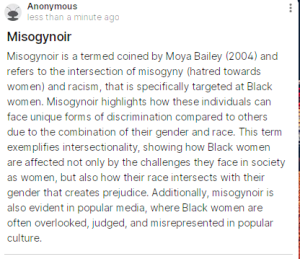
B) Representing Race
Exercise 2: Notebook Prompt
In about 50-70 words, consider Joel Bervell’s question: why do we feel the need to extrapolate the athleticism of one Black athlete to all Black people when we do not do the same for white athletes?
Try to think of examples when this happens, making sure to reflect on your own positonality.
Joel Bervell’s question highlights the concerning issue regarding the stereotypes often associated with black athletes and their performance in sports. This narrative is not applied in similar situations towards white athletes, where instead they are praised for their individualistic achievements. Contrary to being celebrated for individual performance, black athletes are often subjected to being generalized as a group when it comes to their physicality. For example, Tom Brady’s performance in sport is often looked at as an exceptional ‘greatness’, whereas Usain Bolt’s incredible achievements are often reinforced by the stereotype that black athletes may possess a certain type of athletic greatness. As a white female, I recognize the need for change when it comes to conversations about black athletes’ successes, and the need to appreciate an athlete’s individual achievement amongst all races, rather than further reinforcing stereotypes.
C) Gender, Race & Sport
Exercise 3: Notebook Prompt
What are some strategies for resistance that Rajack and Joseph identify in their article as a means of pushing back against and resisting misogynoir?
The authors of this article highlight the challenges athletes can face when being thrown in the media while also showing how multiple athletes experience the repercussions of misogynoir. The first strategy that the authors identify in this article as a means of pushing back against misogynoir is using social media platforms for the better. Although misogynoir is found heavily in the media and its conversations, individuals can also use their social media platforms to stand up for the rights of individuals and athletes who have experienced forms of misogynoir, and collectively hold others accountable for their actions in the media that causes harm (Razack & Joseph, 2021). Secondly, the authors highlight how using comedic forms of resistance to racism can be effective in the media as well (Razack & Joseph, 2021). For example, the authors show how Naomi Osaka responded to racist comments on twitter using forms of comedy, ultimately showing how absurd and rude conversations about her in the media can be pushed back against: “Too sunburned’ lol that’s wild. Little did they know, with Shiseido anessa perfect uv sunscreen I never get sunburned”. Lastly, Naomi Osaka exemplifies another form of resistance to misogynoir by using positive commentary about her racial background and sharing her proudness of where she comes from.
Overall, the strategies in this article such as using ICTs for positivity and collectiveness, using comedic language, and honouring racial backgrounds, can all be beneficial when it comes to resisting and protesting against negative conversations and comments that perpetuates misogynoir.
Section Two: Making Connections
A) Athlete Activism
Exercise 3: Padlet Prompt
Do athletes have a responsibility to use their platform for social change? Why or why not? Please remember to record your response in both the padlet below and in your Notebook.
I believe that athletes do have the ability to use their platform for effective social change. Professional athletes are seen as role models, influencers to their fans, and as people whose feeling’s and opinions are valued. In the advanced technological world we live in today, social media has become an influential space where athletes can help share their views on important social justice issues, promote change, and supply access to resources for their followers to engage with.
I believe that many athletes, much like other celebrities who have a massive following, possess the power to promote positive social change. This power allows them to advocate for change through their words in the media and social media posts. This can be very beneficial for important social justice issues going on in the world right now, and issues within the sport community.
When watching the video of LeBron James, it is inspiring to hear his story about him standing up for the things he believes in, despite backlash from others in the entertainment world. I loved his perspective of using his platform for the things he values, especially human rights matters. Additionally, I loved hearing about his acknowledgment of his platform and knowing that the things he speaks out about can have a huge impact on others.
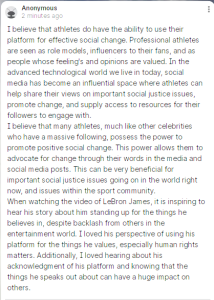
B) Athlete Activism & Feminism
Exercise 4: Complete the activities
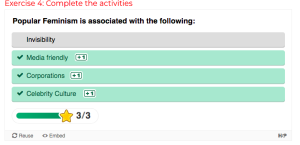
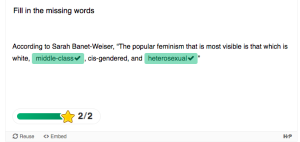
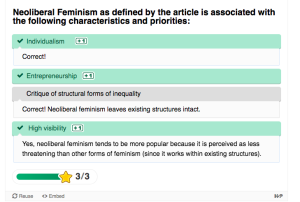
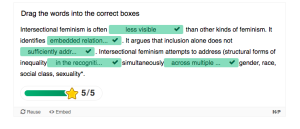
Exercise 5: Notebook Prompt
What do the authors of the article call for as a way of challenging how mainstream sports journalism privileges neoliberal feminist concerns? (100 words max.)
The authors of this article highlight the need to ‘tell stories differently’ when it comes to sports media, and the need to acknowledge the history of feminism in multiple ways (Cooky & Antunovic, 2020). This article expands on the need for more intersectional feminist views when it comes to mainstream sports journalism that tends to solely focus on neoliberal feminist narratives. By telling stories about feminism differently, this allows current mainstream narratives to incorporate past and current views of all sorts of feminism, in hopes for more effective change in society (Cooky & Antunovic, 2020).
C) Corporate social justice
Exercise 6: Padlet Poll
When reading this article, I believe that sport leagues do in fact hold different views when it comes to speaking out on important issues such as BLM. This article highlights how after Kaepernick’s brave decision of kneeling during the national anthem to show support towards the BLM movement, the NFL showed their true colours when it comes to their beliefs about athletes standing up for social justice matters. It seems as though the NFL tends to value athletes not having a voice for the public to hear regarding important issues in society, in hopes to ‘protect’ their players status. Contrary to this, the NBA shows more support of their players promoting and expressing support for social justice initiatives, especially those of the BLM movement. It is inspiring to hear about Kaepernick’s ability to use his platform and popular status for promoting change, in hopes that it will spark conversations about real heartbreaking issues going on in the world.
Section Three: Taking a shot
Module Assignment (submit as part of notebook and separately through Blackboard mini assignment #1 portal)
The movie, Brian Banks, portrays the real life story of a young African American football player who spent 6 years in jail after being wrongfully accused of rape in 2002. Brian Banks had an amazing talent for football where he was a highly successful athlete pursuing a professional career. In 2002, everything changed when he was falsely convicted of rape. Brian faced many struggles in his time spent at court, constantly trying to prove himself innocent despite the lack of evidence surrounding his case. Although no signs showed that Brian Banks was a guilty man, this movie highlights the systemic racist barriers that exist within the court system that many black individuals can face.
Brian Banks uses his words to show how barriers exist within the court system, which are inherently unjust towards certain groups of people. One particular quote that stood out to me was when Brian was talking to Justin Brooks, he says, “Justin, I know the system doesn’t care about me. I’ve known that my whole life. The question is, do you?”. This quote is hard hitting, as Justin Brooks, despite being Brian’s well-intentioned white criminal defence lawyer, will never fully understand the lived experiences of individuals like Brian due to racial differences. This story relates to the reading by Razack & Joseph, as it shows how just like black female athletes in the light of the media can experience misogynoir, these athletes can also be impacted by intersectionality within the criminal justice system. Sadly, many intersecting factors such as gender, race, and class can impede on the experiences of marginalized groups of people, especially in court.
To this day, Brian continues to be a social activist about systemic barriers that exist within the court system, using his platform for good and standing up against prejudice that exists within our society, and promoting social justice reform. This relates to the reading, Sport and Social Justice, which explained how the athlete Colin Kaepernick used his high social platform to stand up in what he believes in, influencing multiple people along the way.
Overall, the movie, Brian Banks, highlights the saddening truth behind systemic barriers and the impacts of intersectionality that exists within the court system. Additionally, the story of Brian Banks shows the need for social justice change when it comes to wrongfully convicting those who are not deserving.
References
Khabbaz, R. (2021). Sports and social justice. Harvard Business Review. https://hbr.org/2021/01/sports-and-social-justice
Razack, S., & Joseph, J. (2020). Misogynoir in Women’s Sport Media: Race, Nation, and diaspora in the representation of Naomi Osaka. Media, Culture & Society, 43(2), 291–308. https://doi.org/10.1177/0163443720960919

